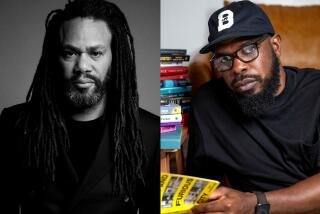The Birth of the Hollywood Blacklist : Radio: ‘The Waldorf Conference’ dramatizes the ’47 meeting at which the industry devised a strategy to combat the supposed Red menace. The ‘work of speculation’ will be broadcast live tonight.
Once again the ghosts from Hollywood’s infamous blacklist era are up for visitation.
After a spate of films and documentaries, now comes “The Waldorf Conference,” a drama that will be broadcast live at 8 tonight on KCRW-FM (89.9), with a theatrical performance Friday at Santa Monica’s Guest Quarters Suite Hotel--all of it courtesy of L.A. Theatre Works.
For the record:
12:00 a.m. Oct. 30, 1993 For the Record
Los Angeles Times Saturday October 30, 1993 Home Edition Calendar Part F Page 13 Column 6 Entertainment Desk 1 inches; 28 words Type of Material: Correction
Actor’s name-- One of two actors rehearsing for a radio drama, “The Waldorf Conference,” was incorrectly identified in a photo caption Thursday. The actors were Charles Durning and John Randolph.
But unlike other productions, this script focuses on how “The Unfriendly 10” (so dubbed by the House Committee on Un-American Activities--HUAC for short) came to be sacrificed to the Communist witch hunt by 48 movie industry potentates who met Nov. 24-25, 1947, at New York’s Waldorf-Astoria Hotel.
“Everyone knows the Hollywood 10,” says journalist Nat Segaloff, who wrote the play with TV writer-producer Arnie Reisman and Daniel M. Kimmel, another journalist. “But what about the Hollywood 48, who disavowed their colleagues and cut deals with HUAC? These were the guys--Louis B. Mayer, Samuel Goldwyn, Harry Cohn and others--who invented the blacklist.”
No one can say with certainty who said what that fateful day because no notes were kept--deliberately; thus “The Waldorf Conference” is being billed as “a work of speculation” by the authors (and, “in the interest of clarity and drama,” the number of participants has been reduced from 48 to 12).
“For writers like me--a blacklist nut not unlike the J.F.K. conspiracy-theory nuts--it was easy to piece together speeches, trade-paper reports, studio archive material. But I don’t want to be known as the Joe McGinniss of the blacklist,” Segaloff jokes, referring to the imagined thoughts and statements attributed to Sen. Edward M. Kennedy (D-Mass.) in a biography by that author.
What drew the authors--and actors Ed Asner, Charles Durning, Ron Rifkin and others--to the story was the idea, Segaloff says, that “a few good men” could stoop to betrayal, “never imagining the harm they would do, the lives they would ruin. In my mind they were not unlike the SS functionaries, who were more concerned with the number of boxcars needed to transport Jews to death camps than the murderous result.”
But the “chilling” part, he says, came from understanding the moguls’ predicament.
*
HUAC had just concluded two weeks of hearings and, despite the Red-baiting rhetoric tossed about, could find no evidence of Communist infiltration of the movies. Nevertheless, the committee issued indictments, citing the 10 writers, producers and directors for contempt of Congress. (They refused to answer the “Are you now or have you ever been . . .” questions.) Public opinion was inflamed. The finger pointed at Hollywood, and industry leaders had to do something to avert suspicion.
“At least those were the surface concerns,” Segaloff says. “But the real fears involved box office. In 1947, television was introduced, studio profits were down 25%, Wall Street investors seemed nervous and foreign markets were not paying their film rental bills.”
So the 48 studio chiefs, theater operators and other industry executives who convened at the Waldorf had a rare chance not only to rid Hollywood of a lingering cloud--by issuing the blacklist and vowing to fire, on a morals charge, any others who would disgrace filmdom--but also to enjoy the government’s turning its head to potential anti-trust violations.
“Normally, theater owners and producers were not allowed to confer or exchange information,” Segaloff says. “But for once they could talk their bread-and-butter issues. My guess is these agendas were the important ones--not sacrificing 10 men to the blacklist. That was a small price for getting the government off their backs.”
“The Waldorf Conference” puts one in mind of another famously speculated production with the same initials: “The Wannsee Conference,” a 1984 German-Austrian film about the powerful Nazis who met at an elegant retreat to determine the fate of the Jews.
“We thought about that,” says Segaloff, “and that all 48 are dead now, as well as the Hollywood they created.” Reisman points out, however, that these movie tycoons were, prior to their success, “lowly pants manufacturers with all the instincts for collusion and greed.”
“There was only one with a conscience,” he says. “Dore Schary (president of RKO Radio Pictures), who was educated and an East Coast intellectual, had the sensibility to know what an awful thing they were about to do.” Schary, played by Ron Rifkin, is the radio drama’s moralistic tragic hero.
“Waldorf” was originally written as a script for a film or play, but it has yet to be presented to anyone in that form because, as Reisman explains, “Ed Asner read it and immediately asked Susan Loewenberg, L.A. Theatre Works’ director, to produce it as a radio treatment. We plan to offer it next in the original, raw-language version.”
More to Read
The biggest entertainment stories
Get our big stories about Hollywood, film, television, music, arts, culture and more right in your inbox as soon as they publish.
You may occasionally receive promotional content from the Los Angeles Times.










